You’ve meticulously assembled your pedalboard, spent countless hours dialing in your amp’s sweet spot, and curated a guitar collection that covers every sonic landscape. But have you given equal consideration to the unsung hero connecting it all? While often overlooked, investing in the Best Guitar Cables is essential for any guitarist serious about their sound.
Those budget-friendly cables you find online might seem appealing, but they often come with a hidden cost: unwanted noise infiltrating your carefully crafted guitar tone. And let’s not even talk about the frustratingly high failure rate of their connectors. Upgrading your guitar cable is more than just a sonic improvement; it’s about reliability and saving yourself from the mid-performance nightmare of troubleshooting a faulty cable. We’ve all been there, hunched over our pedalboards, desperately searching for the weak link.
For the ultimate in cable performance, look no further than Mogami Gold guitar cables. While they represent a premium investment, their reputation as the industry gold standard is well-earned, with countless professional guitarists relying on them. If Mogami Gold is beyond your current budget, don’t worry. Exceptional quality doesn’t have to break the bank. Ernie Ball Braided cables offer outstanding sound quality and robust durability without the premium price tag.
Our team at guitarplayers.net has rigorously tested countless cables across diverse playing scenarios – from home practice sessions to professional studio recordings and demanding tour environments. To equip you with comprehensive knowledge before making a purchase, we’ve included a detailed FAQ section at the end of this guide, drawing on the expertise of our seasoned writers. If you’re ready to dive straight into our top product recommendations, keep scrolling to discover the best guitar cables available today.
Best Overall
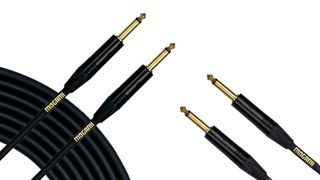 Mogami Gold Series guitar cable connectors and coiled cable section
Mogami Gold Series guitar cable connectors and coiled cable section
If you demand the absolute best signal transmission and noise rejection, Mogami Gold is the gold standard (Image credit: Mogami)
1. Mogami Gold Series Guitar Cable
The Undisputed Champion: The Gold Standard for Guitar Cables
Expert Review:
Specifications
- Features: Oxygen-free copper conductor, carbon-impregnated PVC, Neutrik black and gold plugs, ultra-high density spiral shield, conductive polymer sub-shield, lifetime warranty, 130pF/m capacitance
- Connection: 1/4” straight-to-straight / straight-to-right-angle
- Length: 3ft, 6ft, 10ft, 12ft, 15ft, 20ft, 25ft
Reasons to Buy
- Unrivaled noise rejection for pristine signal clarity
- Backed by a lifetime warranty for peace of mind
- Available in a wide range of lengths to suit any setup
Reasons to Avoid
- Premium price point may be overkill for some users
- The “gold” aesthetic might not appeal to everyone
The Mogami Gold Series guitar cable is engineered with an ultra-high density (UHD) spiral shield and a conductive polymer sub-shield, working in tandem to eliminate unwanted noise and faithfully preserve your guitar’s signal integrity. A conductive carbon-impregnated PVC layer further minimizes handling noise and microphonic pops, common issues with lesser cables.
While featuring a heavy-gauge copper core conductor, the Gold Series maintains excellent flexibility and ease of handling, making it gig-ready and convenient to pack. For performing musicians seeking the ultimate in convenience, the Gold Series Silent option incorporates Neutrik silent plugs, enabling seamless instrument changes without the need to mute your amplifier.
Mogami stands firmly behind the Gold Series with a comprehensive “no excuses” lifetime warranty, demonstrating their commitment to quality and durability. Offered in an extensive selection of lengths, the Gold Series caters to diverse setup requirements. While the premium features of the Gold Series might be considered over-engineered for some players, for those who prioritize uncompromising quality and sonic purity, it simply doesn’t get any better.
Best on a Budget
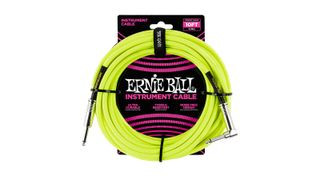 Ernie Ball Braided guitar cable showcasing durable braided jacket
Ernie Ball Braided guitar cable showcasing durable braided jacket
Experience premium cable performance without the premium price tag with Ernie Ball Braided cables (Image credit: Ernie Ball)
2. Ernie Ball Braided Guitar Cable
Road-Ready Reliability and Performance for Guitarists on a Budget
Expert Review:
Specifications
- Features: Dual conductors, tangle-resistant braided jacket, 99.95% oxygen-free copper conductors for corrosion resistance, dual-shielded, dual-conductor design
- Connection: 1/4” straight-to-straight / straight-to-right-angle
- Length: 10ft, 18ft, 25ft
Reasons to Buy
- Exceptionally durable construction for demanding use
- Tangle-resistant braided jacket for hassle-free handling
- Noise-free design ensures clean signal transmission
Reasons to Avoid
- Limited length options, starting at 10ft minimum
Ernie Ball has established a reputation for building guitar cables that are built to withstand the rigors of performance, and their Braided models take durability to the next level. Designed with a robust, tangle-resistant braided jacket, these cables are ideal for gigging guitarists, touring musicians, or anyone who prioritizes convenience and durability over meticulous coiling.
Beneath the braided exterior, dual conductors work to deliver your guitar’s tone with exceptional clarity and fidelity. Our testing revealed crisp highs, articulate mids, and rich harmonic content, demonstrating the cable’s ability to preserve your instrument’s sonic nuances. Internally, effective shielding minimizes noise interference and maintains optimal signal strength.
While length options are somewhat limited, Ernie Ball Braided cables are available in practical 10, 18, and 25ft lengths, catering to common stage and studio setups.
Best for Options
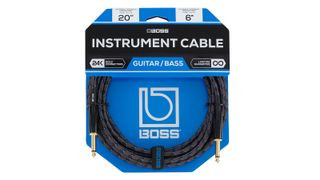 Boss Instrument Cable in retail packaging, highlighting variety of lengths and connector types
Boss Instrument Cable in retail packaging, highlighting variety of lengths and connector types
Boss instrument cables offer a winning combination of quality, value, and versatile length options (Image credit: Boss)
3. Boss Instrument Cable
Versatile Performance and Value: A Top Choice for Guitarists Seeking Options
Expert Review:
Specifications
- Features: Studio-grade, oxygen-free copper core wire, 24K gold-plated contacts, heavy-duty braided shield
- Connection: 1/4” straight-to-straight / straight-to-right-angle
- Length: 1ft, 3ft, 5ft, 10ft, 15ft, 20ft, 25ft
Reasons to Buy
- Extensive range of lengths, from short patch cables to long stage cables
- Excellent value for money, delivering quality without a high price tag
- Durable construction ensures reliable performance
Reasons to Avoid
- May not offer the absolute pinnacle of sonic performance compared to ultra-premium options
Boss instrument cables strike an impressive balance between quality construction and affordability. The moment you handle a Boss cable, the quality is immediately apparent. Built with premium materials, these cables are designed to transparently transmit your guitar’s inherent tone without noticeable coloration.
Featuring heavy-duty braided shielding, Boss cables effectively block unwanted microphonic noise, ensuring a clean and quiet signal path. The robust jacks provide a secure and reliable connection, and the cable’s material facilitates easy coiling and handling, contributing to long-term durability with proper care.
One of the standout features of Boss instrument cables is the wide array of available lengths, catering to virtually any application, from short patch cables for pedalboards to extended lengths for larger stages. Angled jack options further enhance versatility. In our experience, Boss instrument cables represent exceptional value for money, making them a top contender among the best guitar cables for players seeking a reliable and versatile solution without breaking the bank. For those desiring the absolute highest echelon of cable performance, Boss also offers a premium cable range.
Also Consider
While our top recommendations cover the needs of most guitarists, those seeking specialized solutions should explore these excellent alternatives:
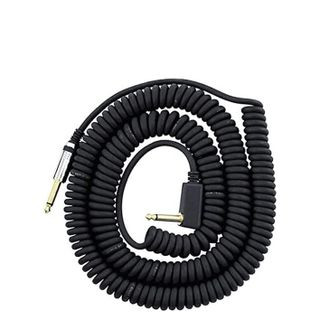 Vox Premium Vintage Coiled cable showcasing retro aesthetics
Vox Premium Vintage Coiled cable showcasing retro aesthetics
Best Coiled
4. Vox Premium Vintage Coil
Connection: 1 x 1/4″ straight, 1 x 1/4″ right-angle jack
Length: 30ft (9m)
Pros:
- Iconic vintage aesthetic
- High-quality cable components
- Robust build quality
Cons:
- Coiled cable look may not appeal to all players
- Coiled design can be less practical for some setups
For guitarists who embrace vintage aesthetics and tone, the Vox Premium Vintage Coil cable is a perfect match. While coiled cables sometimes face criticism from purists who claim inferior sound quality, Vox dispels this myth with this exceptional cable.
The key lies in the high-purity, 99.9% oxygen-free copper wire used in the Premium Vintage Coiled cable. This premium conductor delivers a warm, pronounced midrange response that enhances the vintage character of your guitar tone. The cable is meticulously constructed with two separate shields to maximize strength and minimize noise and interference. While the coiled look is a matter of personal preference, for players seeking vintage vibe and authentic tone, the Vox Premium Vintage Coil is an outstanding choice.
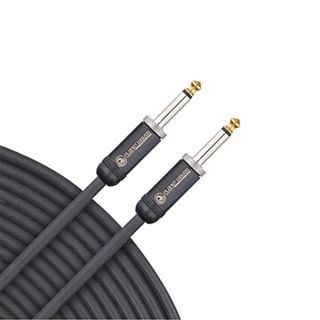 D’Addario Planet Waves American Stage Cable featuring Geo-Tip plug design
D’Addario Planet Waves American Stage Cable featuring Geo-Tip plug design
Best for Live
5. D’Addario Planet Waves American Stage
Features: 22 gauge oxygen-free copper twisted pair conductors, 95 percent tinned copper braid shielding, Geo-Tip plugs, approx 92pF/m capacitance
Connection: 1/4” straight-to-straight / straight-to-right-angle
Length: 10ft, 15ft, 20ft, 25ft, 30ft
Pros:
- Patented Geo-Tip plugs for enhanced jack compatibility and secure connection
- Low capacitance design preserves high-frequency response
Cons:
- Limited outer jacket color options
- May not appeal to players seeking ultra-premium cable performance
The Planet Waves American Stage cable stands out with its patented Geo-Tip plugs, a significant innovation for live performance reliability. These plugs, manufactured by Neutrik in Liechtenstein to Planet Waves’ exacting specifications, feature a slightly flattened tip and extended shield. This unique design ensures a snug, crackle-free connection with virtually any guitar jack, regardless of manufacturer tolerances. The tinned-copper braid shielding further protects your signal from unwanted noise and interference on stage.
HelioFused soldering, another Planet Waves exclusive, creates a robust 180-degree inline connection, contributing to the American Stage cable’s exceptional durability and stage-ready performance. These cables are also readily available at an accessible price point, with both straight and right-angled connector options.
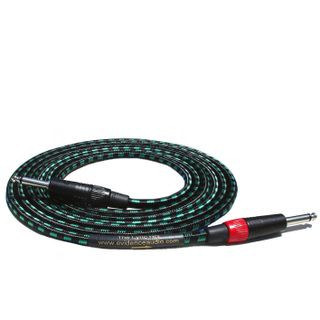 Evidence Audio Lyric HG guitar cable showcasing robust construction and high-end connectors
Evidence Audio Lyric HG guitar cable showcasing robust construction and high-end connectors
Best Durability
6. Evidence Audio Lyric HG Guitar Cable
Features: Dual solid-core conductors made of refined IGL copper, braided copper shielding, and a tough nylon/rubber outer jacket
Connection: 1/4″ phone plug on the input side and a straight plug on the output
Length: 10ft, 20ft
Pros:
- Exceptionally pure signal path for maximum tonal transparency
- Incredibly robust construction for ultimate durability
- Expertly crafted with premium components
Cons:
- High price point represents a significant investment
The Evidence Audio Lyric HG is the cable of choice for discerning guitarists like David Gilmour, Jeff Beck, and John Mayer, and for good reason. Its unique design features dual solid-core conductors crafted from refined IGL copper. This solid-core construction delivers a demonstrably purer signal path and superior tone compared to conventional multi-strand cables. While the solid-core design results in a slightly stiffer cable, the braided copper shielding and rugged nylon/rubber outer jacket ensure exceptional durability for years of reliable performance.
The primary drawback of the Lyric HG is its premium price. However, our testing confirms that the investment is justified by the unparalleled quality and sonic performance. If absolute signal purity and unwavering durability are paramount, and budget is less of a concern, the Evidence Audio Lyric HG is in a class of its own. If it’s good enough for John Mayer, it’s certainly worth considering for your rig.
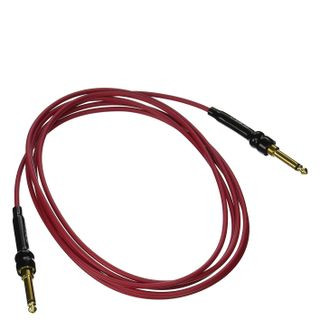 George L’s .155 guitar cable highlighting thin, flexible design and solderless connectors
George L’s .155 guitar cable highlighting thin, flexible design and solderless connectors
Best Lightweight
7. George L’s .155 Guitar Cable
Features: Solder-less connection system, George L’s .155 connectors, high-density braided shielding, 67pF/m capacitance
Connection: 1/4” straight-to-straight / straight-to-right-angle
Length: 10ft, 20ft
Pros:
- Ultra-low capacitance for maximum high-frequency retention
- Lightweight and rugged construction
- Solderless connectors for custom cable lengths
Cons:
- Build-your-own solderless system may require some assembly
- Thin cable design may not appeal to all players
George Lewis is renowned for offering his .155 cable in bulk, empowering guitarists to create custom cable lengths using his innovative solderless connector system. George L’s cables are also celebrated for their exceptionally low capacitance. Eric Johnson, known for his meticulous tone, is a devoted user. It’s challenging to find another guitar cable on the market with a lower capacitance per meter. The frequency response is outstanding, and the signal is effectively shielded.
These ready-made cables come pre-assembled with George L’s solderless .155 connectors. Despite the vintage feel of the thin cable diameter and its tendency to coil, they possess surprising toughness. For players who find the .155 gauge too slender, the .255 version offers identical sonic performance in a thicker, heavier cable.
 Fender Deluxe Series Instrument Cable featuring tweed jacket and gold-plated connectors
Fender Deluxe Series Instrument Cable featuring tweed jacket and gold-plated connectors
Best Warranty
8. Fender Deluxe Instrument Cable
Features: 24K gold-plated connectors, 20 AWG 99.99 percent oxygen-free copper conductor, 95 percent braided oxygen-free copper shielding, molded plugs with strain relief, yellow or black tweed outer jacket, hook-and-loop cable tie
Connection: 1/4” straight-to-straight / straight-to-right-angle
Length: 5ft, 10ft, 15ft, 20ft, 25ft
Pros:
- Excellent value with a lifetime warranty for long-term assurance
- Includes a free cable tie for organized cable management
Cons:
- May not be necessary for players with unlimited budget
- Tweed jacket aesthetic may not suit all tastes
Fender’s Deluxe Series instrument cables often fly under the radar, but their lifetime warranty and robust construction make them a high-performance option at a competitive price. The custom-molded plugs incorporate strain relief for enhanced durability and a secure connection. The Deluxe Series shielding effectively minimizes extraneous noise, performing comparably to more expensive cables.
These cables have a substantial 8mm diameter yet coil neatly and include a cable tie to encourage organized cable management. In our listening tests, the Fender Deluxe Series cables exhibit a bright and transparent character, particularly the 10-foot length, and feel robust enough for the demands of the road. A worthy contender in our best guitar cables guide.
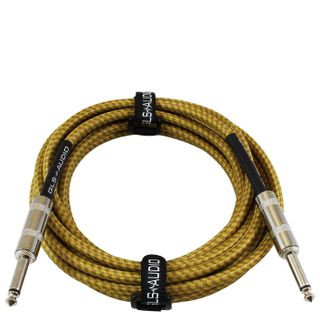 GLS Audio Tweed guitar cable highlighting vintage-inspired tweed jacket
GLS Audio Tweed guitar cable highlighting vintage-inspired tweed jacket
Best Vintage
9. GLS Audio Tweed Guitar Cable
Features: Triple-strain relief, oxygen-free copper conductor, oxygen-free copper shielding, conductive PVC shield, plastic conductive carbon shield, approx 125pF/m capacitance, available in brown or black tweed
Connection: 1/4” straight-to-straight / straight-to-right-angle
Length: 6ft, 10ft, 15ft, 20ft
Pros:
- Low capacitance design for clear and bright tone
- Vintage tweed jacket for classic aesthetics
Cons:
- Tweed jacket style may not appeal to all players
Purchasing GLS Audio Tweed guitar cables directly from GLS can offer significant savings compared to typical retail prices. The tweed outer jacket presents a striking vintage aesthetic in both black and brown options. The GLS Audio Tweed cable offers a pleasing feel, coils easily, and exhibits excellent durability, making it particularly appealing to vintage enthusiasts.
This cable is double-shielded and features low capacitance, ensuring quiet operation without compromising high-frequency response. Straight-to-straight and straight-to-right angle configurations are offered at the same price point. In our testing, the GLS Audio cable delivered a remarkably accurate and full-bodied reproduction of our guitar’s tone. For its price point, the performance is impressively competitive against other brands in the same range.
How to Look After Your Guitar Cables
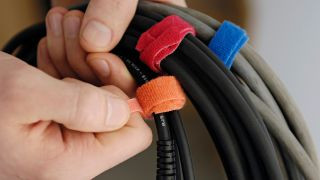 Man holding coiled guitar cables with velcro straps for cable management
Man holding coiled guitar cables with velcro straps for cable management
Proper cable care is crucial for maximizing lifespan and performance. Investing in the best guitar cables is only worthwhile if you treat them with care (Image credit: Future)
Taking good care of your cables is just as important as choosing quality ones. There’s no point investing in the best guitar cables if you’re not going to treat them well. Proper coiling when not in use and being mindful of stepping on them (especially on crowded stages) are essential practices. Ensuring your amp or pedalboard isn’t inadvertently trapping cables is another seemingly obvious yet often overlooked step that can prevent premature cable failure.
Here are our top tips for extending the life of your guitar cables:
1. Pull the Plug – Correctly
Always disconnect your cable by gripping the plug itself, not the cable. Inside the plug, the cable is soldered to the connector. Pulling on the cable can weaken this soldered joint over time, leading to eventual failure.
2. Cable Looping for Strain Relief
As observed with professional guitarists on stage, looping your cable through your guitar strap is a smart technique. This not only reduces the risk of tripping but also minimizes strain on the cable and connector if the cable is accidentally tugged while plugged in. Similarly, looping the amp end of the cable through the amp handle prevents accidental pull-outs.
3. Mind Your Footsteps
Consciously avoid stepping on your guitar cables whenever possible. During setup, make it a habit to position your amp, pedalboard, and guitar in their optimal locations before connecting any cables.
4. The Advantage of Right Angles
Right-angled cables are invaluable in specific scenarios where minimizing cable stress is crucial. For amps with top-mounted input jacks, a right-angle cable relieves downward pressure on the connector. Likewise, right-angle cables on pedalboards reduce the risk of damage from accidental foot traffic.
5. Master the Cable Wrap
Learning the correct method for wrapping your cables is a fundamental skill that will serve you throughout your musical journey. Studio and sound engineers will appreciate your professionalism, and proper wrapping keeps your gear organized and extends cable life. It also significantly speeds up setup and teardown times.
While detailed wrapping instructions are beyond the scope of this guide, numerous online video tutorials demonstrate the proper technique.
FAQs
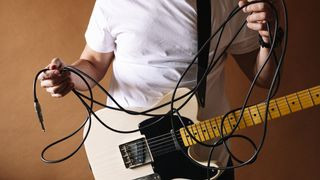 Man holding a guitar cable and pondering cable maintenance and selection
Man holding a guitar cable and pondering cable maintenance and selection
(Image credit: Getty Images)
Do I need a different cable for acoustic, electric, or bass guitar?
No, a specialized cable isn’t required for different instrument types. Electric guitars, acoustic-electric guitars, and basses all utilize 1/4″ jack connections, making any standard instrument cable universally compatible. However, while cable type is consistent across instruments, considering connector type and length remains important.
Decide whether a straight or angled jack best suits your instrument’s output jack location. Guitars with jacks on the body face often benefit from angled cables. Conversely, some acoustic guitars, due to their body shape, may be better suited to straight connectors.
How long should a guitar cable last?
High-quality guitar cables are designed for durability. With proper care, you can expect years of reliable use, often exceeding a couple of years without issue. Investing in quality cables translates to robust construction and premium components, particularly the jack plugs and cable materials. Effective shielding within the cable is also crucial for noise protection when the cable is moved or handled.
What is cable capacitance?
Cable capacitance, an electrical property inherent in all cables, can subtly influence your guitar tone. Capacitance refers to a cable’s ability to store an electrical charge. Ideally, a guitar cable should facilitate signal flow, not impede it. Higher capacitance can cause a roll-off of high-end frequencies, effectively reducing treble in your tone. Low-capacitance cables minimize this effect, preserving a fuller frequency response. While the difference may not be dramatic, it is a factor in overall tone.
What length guitar cable do I need?
When selecting the best guitar cable, opt for the shortest length practical for your setup. Similar to capacitance, longer cables can contribute to high-frequency roll-off. Of course, the inherent tonal characteristics of your guitar and amplifier are also factors – you might, in some cases, desire a slight treble reduction. However, in general, shorter, low-capacitance cables are preferable for optimal signal fidelity.
How much should I spend on a guitar cable?
In guitar cables, as with many things, you generally get what you pay for. Budget cables may seem attractive initially, but the adage “buy cheap, buy twice” often applies. Ultra-budget cables are prone to noise, can degrade your tone, and are likely to fail sooner. Investing in the best guitar cables ensures your rig’s sonic integrity is maintained and the cables can withstand the demands of regular use.
What are guitar cables made of?
Various materials are employed by different cable manufacturers. Copper is typically the core conductor material. While gold-plated jack plugs are common on premium cables, their impact on tone is minimal, though they offer enhanced corrosion resistance.
Are guitar cables balanced?
Guitar cables are unbalanced, rendering them susceptible to external interference and microphonic noise. This is a primary reason why investing in high-quality cables is particularly important, especially in complex pedalboard setups.
Guitar cables are mono, transmitting a single copy of your signal. This single-signal transmission makes them vulnerable to picking up extraneous noise along the cable path. Balanced cables, in contrast, transmit two copies of the signal, with one inverted to cancel out noise encountered along the way.
Unfortunately, balanced cables are generally incompatible with guitar amplifiers. Guitar amps typically require TS (tip-sleeve) connectors, while balanced cables use TRS (tip-ring-sleeve) connectors.
Balanced cables are commonly used with other audio equipment such as synthesizers, studio monitors, PA systems, and microphones, and are recommended for cable runs exceeding 25 feet.
Can guitar cables cause buzz?
Pinpointing the source of buzz in a signal chain can be complex, as any component can potentially introduce noise. Even external electrical devices near your setup can contribute to buzzing. While a guitar cable isn’t always the primary culprit, it can certainly be a source of unwanted noise.
The most effective method for identifying noise sources is systematic isolation testing of each component. This process can be time-consuming but is often the only way to definitively locate the origin of unwanted noise. Noise issues can also accumulate across multiple pedals or cables in a chain.
Remember to check for nearby electrical devices like computer monitors or mobile phones, as these can also induce buzz in your signal.
How We Choose
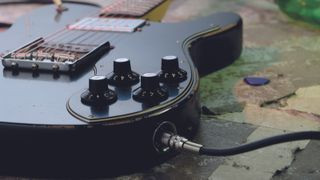 Guitar cable plugged into a vintage electric guitar, emphasizing connection and tone
Guitar cable plugged into a vintage electric guitar, emphasizing connection and tone
(Image credit: Future)
The team at guitarplayers.net is comprised of passionate and experienced guitarists. Collectively, we have extensive hands-on experience with a vast array of guitar cables across diverse playing environments – from festival stages to professional recording studios and weekly rehearsals. We are all dedicated to achieving the best possible guitar tone.
For us, a top-tier guitar cable must excel in various applications, but sonic performance remains paramount. Cheap cables introduce unwanted noise, which is unacceptable. Our primary evaluation criterion is noise rejection. We rigorously test cables for quiet operation, whether plugging directly into an audio interface or incorporating them into complex gig rigs with amps and pedalboards.
Durability is our next critical assessment. We subject cables to the rigors of regular practices, tours, studio sessions, and home use to ensure they can withstand constant use. Our extensive experience allows us to quickly discern cable quality, particularly in connector robustness, a common point of failure.
Recognizing that individual guitarists have diverse cable preferences, we strive to provide recommendations that cater to a broad spectrum of players. While no single cable suits every guitarist, our real-world experience enables us to recommend cables that will meet the needs of the vast majority. As guitarists ourselves, we only recommend products we are confident using ourselves, ensuring our recommendations are trustworthy and practical.
Learn more about our rigorous product evaluation process and how we test each product in our buyer’s guides and our review policy.
